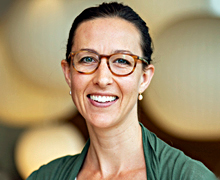Understanding Microchimerism and Immune Development for Infectious Diseases
Detecting maternal cells in cord and infant blood to study their effects on disease susceptibility, immune modulation, and vaccine effectiveness
Technology overview
 Dr. Whitney Harrington
Dr. Whitney Harrington
During pregnancy, cells transfer between the mother and fetus, and some maternal cells persist in the infant postpartum. This transfer of long-lived maternal cells gives most individuals a small population of genetically distinct cells, a phenomenon called microchimerism. Dr. Whitney Harrington studies microchimerism and how it affects early immune development.
Maternal infection during pregnancy appears to increase the number of cells transferred to the fetus. Dr. Harrington found that placental infection with the Plasmodium falciparum malaria parasite during pregnancy results in infants having more maternal cells in their cord blood. In the first few years of life, these children are more susceptible to malaria infection but less likely to get sick or be hospitalized for malaria. Dr. Harrington hypothesizes that the acquired maternal cells act as a “natural” vaccination, so children, although infected, are protected from malaria-related disease. She is now working to understand whether other maternal infections, such as HIV, also increase the size of the maternal graft.
The precise identity and function of transferred maternal cells is unknown. The Harrington group is isolating and characterizing maternal cells from cord and infant blood samples. They are particularly interested in determining if the acquired maternal cells directly provide immunity or control and modulate responses to infectious diseases such as HIV and malaria.
Dr. Harrington is developing sensitive methods to identify and isolate maternal cells, which may be as rare as 1 in 100,000, from cord blood and infant samples. Her lab has expertise in detecting these cells by screening bulk DNA for maternal-specific alleles. She has also identified maternal cells by their XX sex chromosome genotype in boys whose other cells are XY. The Harrington group is now using flow cytometry to isolate cells with maternal-specific markers to characterize the mother's immune cells in cord and infant blood samples.
Dr. Harrington is interested in fundamentally understanding what controls microchimerism and the types of cells that are transferred from mother to fetus. The work has clinical implications in infectious disease transmission, treatment, and vaccination. The results may lead to therapies that alter the immunity of pregnant women, for example through vaccination, to provide protective effects for children, or modulate the immune response of offspring with altered maternal cell grafts.
Stage of Development
- Preclinical in vitro, ex vivo
- Epidemiological analysis
- Disease modeling and outcomes
Partnering Opportunities
- Collaborative research opportunity
- Sponsored research agreement
- Consultation agreement
Publications
- Shree R, Harrington WE, Kanaan SB, Forsyth A, Cousin E, Lopez A, Nelson JL, Gammill HS. Fetal microchimerism by mode of delivery: a prospective cohort study. BJOG. 2019;126(1):24-31.
- Harrington WE, Kakuru A, Jagannathan P. Malaria in pregnancy shapes the development of foetal and infant immunity. Parasite Immunol. 2018;17:e12573.
- Gammill HS, Harrington WE. Microchimerism: Defining and redefining the prepregnancy context – A review. Placenta. 2017;60:130-133.
- Kanaan SB, Gammill HS, Harrington WE, De Rosa SC, Stevenson PA, Forsyth AM, Allen J, Cousin E, van Besien K, Delaney CS, Nelson JL. Maternal microchimerism is prevalent in cord blood in memory T cells and other cell subsets, and persists post-transplant. Oncoimmunology. 2017;6(5):e1311436.
- Harrington WE, Kanaan SB, Muehlenbachs A, Morrison R, Stevenson P, Fried M, Duffy PE, Nelson JL. Maternal microchimerism predicts increased infection but decreased disease due to Plasmodium falciparum during early childhood. J Infect Dis. 2017;215(9):1445-1451.
Learn more
To learn more about partnering with Seattle Children’s Research Institute on this or other projects, email the Office of Science-Industry Partnerships.